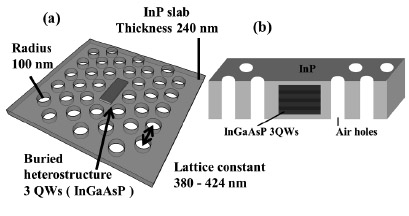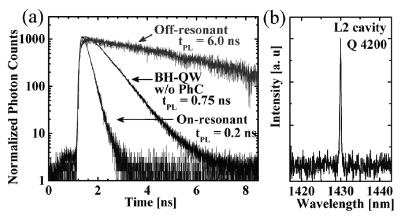Enhanced and Suppressed Spontaneous Emission from a Buried Heterostructure Photonic Crystal Cavity
Chip-scale optical interconnection and photonic network-on-chip architecture are being widely studied. Among various candidates, a photonic crystal (PhC) cavity device is promising because its ultra-small mode volume and high quality factor (Q) will enable high-speed modulation devices, such as lasers and light emitting diodes (LEDs). To realize efficient and ultrafast light-emitting nanophotonic devices, we study spontaneous emission control in a buried-heterostructure (BH) photonic crystal cavity in which InGaAsP quantum wells (QW) are embedded in an InP PhC (Fig. 1). Spontaneous emission from conventional QW-PhC cavities have been extensively investigated, but they suffer from poor carrier confinement and surface non-radiative recombination. Therefore, the spontaneous emission control has been only observed in quantum dots PhC cavities. The present study shows that BH-QW-PhC cavities can exhibit distinctive spontaneous emission control in QW-PhCs because of strong carrier confinement and low surface non-radiative recombination.
In this experiment [1], we examined the emission enhancement and suppression in our samples with different lattice constants at 4K. Figure 2(a) shows the PL decay for the L2 cavity at 1406 nm in an off-resonant condition, at 1430 nm in an on-resonant condition and a reference QW emission, measured at excitation powers of 100 nW, which is 10 times lower than the lasing threshold. Here we used the L2 cavity with a quality factor of 4200 (Fig. 2 (b)). As seen in Fig. 2(a), the on-resonant emission apparently becomes faster, and the emission rate obtained by a single exponential fitting was 4.9×109 s–1 (tPL = 0.2 ns) which is 3.8 times faster than the same-size BH-QW without the PhC structure. The off-resonant emission rate was 1.7×108 s–1 (tPL = 6.0 ns) and 7.5 times slower than the BH-QW emission without a PhC structure. This means that we can control the spontaneous emission rate by a factor of 30 between on-resonant and off-resonant conditions. This is the largest ratio observed in QW-PhCs, and comparable to the best QD-PhCs. The result implies our devices may have high spontaneous emission coupling efficiency, BH-QW-PhC cavities should be promising for devices light emitting based on cavity QED effects, and that they have great potential for realizing very efficient and ultra-fast light-emitting nanophotonic devices.
- [1]
- M. Takiguchi, H. Sumikura, M. D. Birowosuto, E. Kuramochi, T. Sato, K. Takeda, S. Matsuo, and M. Notomi, Appl. Phys. Lett. 103 (2013) 091113.
 |
 |
|
|